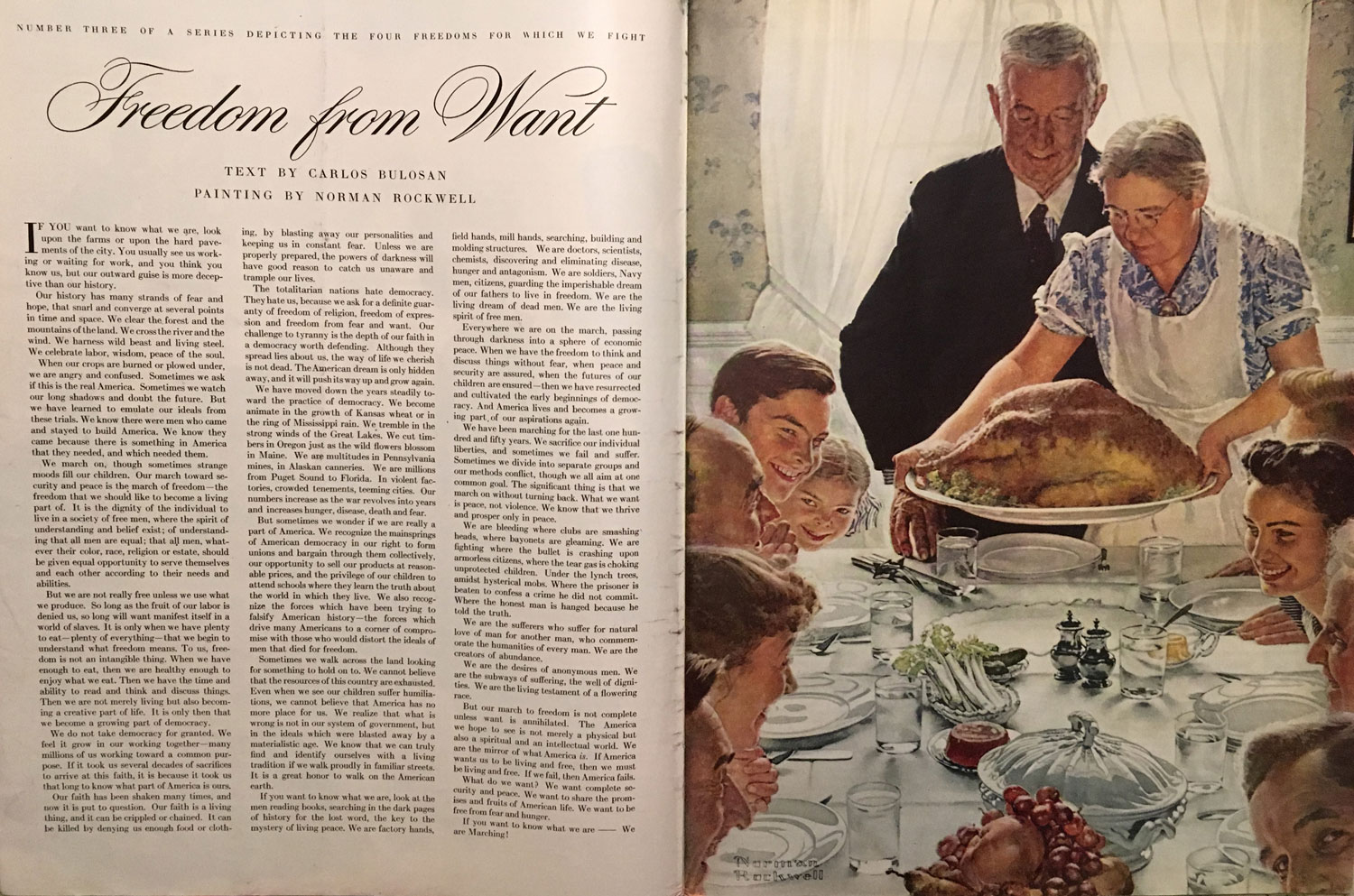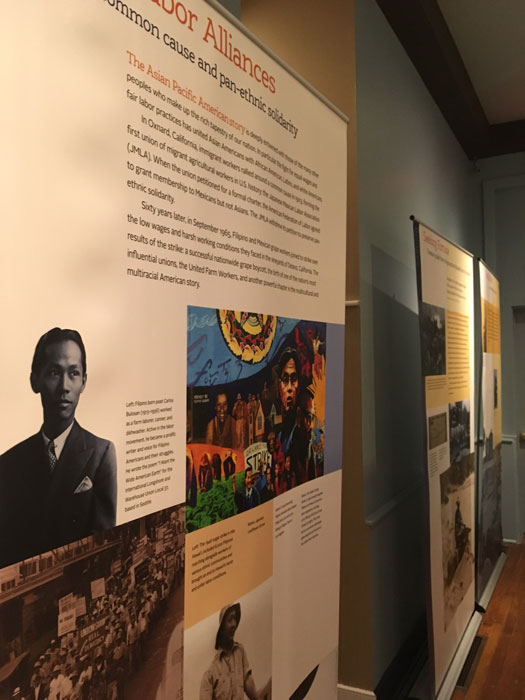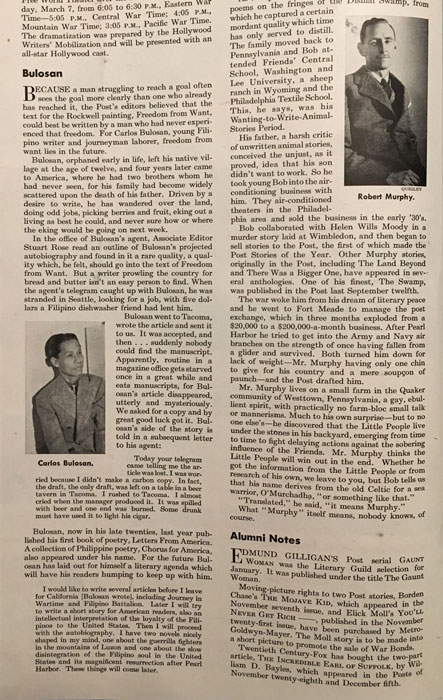When Bulosan Met Quezon

I recognized Bulosan as one of the Filipino literary giants, but it was only in 2013 when I first learned of his famous poem, “Freedom from Want.” It was used in the traveling exhibit, “I Want the Wide American Earth: An Asian Pacific Story,” that was first featured in 2013 at the Smithsonian’s Museum of American History. These few lines from his poem, “Before the brave, before the proud builders and workers/ I say I want the wide American earth/ For all the free,” set the tone for the historical exhibit that featured Asian Americans. The traveling exhibit is part of a 16-city tour and was at the Fairfax Museum until the end of 2018.

In 2016, our family project, The Philippines on the Potomac Project, set up a small exhibit at the Philippine Embassy as part of the Istorya Symposium about Filipino food. The centerpiece of the exhibit was the March 6, 1943 edition of the Saturday Evening Post with Norman Rockwell’s iconic Thanksgiving painting accompanied by Bulosan’s essay, “Freedom from Want.” It was one of the four paintings Norman Rockwell created that featured President Franklin Roosevelt’s Four Freedoms. The Saturday Evening Post published essays by Booth Tarkington (Freedom of Speech), Will Durant (Freedom of Worship) and Stephen Vincent Benét (Freedom from Fear).
Bulosan, a relative unknown compared with the other three more established authors, was selected to write the essay to accompany Rockwell’s “Freedom from Want.” The editors of the Saturday Evening Post were looking for a starving artist who had never experienced “Freedom from Want.” The writer Louis Adamic, who knew Bulosan and liked his work, recommended Bulosan to his own literary agent, Maxim Lieber. At Lieber’s office, the Saturday Evening Post’s associate editor Stuart Rose read Bulosan’s outline of his biography and “found in it a rare quality” that was perfect for the piece. The author’s note of the Saturday Evening Post also mentioned that Bulosan’s essay got lost and the editors had to request a copy of the original. Bulosan who did not make a carbon copy had to rush to the Tacoma bar where he had left the only draft of the manuscript. Bulosan wrote that he “almost cried” when he saw the paper, “spilled with beer and one end was burned.”
Bulosan did not disappoint the editors of the Saturday Evening Post. He wrote simply about hunger and what it meant: “It is only when we have plenty to eat — plenty of everything — that we begin to understand what freedom means. To us, freedom is not an intangible thing.” He explained that once “well fed,” then “we are healthy enough to enjoy what we eat” and “have the time and ability to read and think and discuss things.” He ended with “What do we want? We want complete security and peace. We want to share the promises and fruits of American life. We want to be free from fear and hunger.”

This essay and another unpublished piece, “Problems of Filipinos in the United States,” prompted President Manuel Quezon to invite Bulosan to Washington, DC, presumably to ask him to join the Philippine government-in-exile. Bulosan was at the height of his popularity. Aside from the Saturday Evening Post, he was also published in literary and popular magazines such as the New Yorker, Harper’s Bazaar, Town & Country, The Saturday Review of Literature, The New Republic, and Mademoiselle.

A few months later, after the “Freedom from Want” essay had been published, Bulosan flew to Washington, DC on November 18, 1943. According to his brother, Aurelio Bulosan, Carlos was met at the airport by the latter’s friend P.C. Morantte and immediately went to the office of the government-in-exile housed at the Philippine Chancery on Massachusetts Avenue. Bulosan met with Osmeña and they talked about Bulosan’s essay that was featured in The New Republic. Carlos P. Romulo introduced him to staff members and told him to meet Quezon at the Shoreham Hotel.
In his essay published in Bataan Magazine, Bulosan related how he took a taxi and was “trembling with fear” as he was about to meet “the man who had seen the growth of the Philippines from a backward land to a civilized country.” It took Bulosan an hour to find Quezon’s private secretary Serapio Canceran because “the Shoreham is such a vast hotel.” Zenaida “Nini” Quezon welcomed Bulosan who described her as “Quezon’s intelligent and charming daughter” who made his wait “pleasant and enjoyable.”
When Bulosan was finally with the President of the Philippines, Quezon had difficulty speaking. He was so ill his doctors advised him not to meet with anyone. Bulosan wrote poignantly, “…I sat waiting for the words that did not come out, from a man who has said millions of words in his lifetime.” Quezon finally asked Bulosan his age and what was the matter with his health. Quezon was concerned when he found out they both suffered from tuberculosis. Bulosan was so moved by meeting Quezon, “I’m glad I met the greatest man in my generation.”
Though Bulosan had already decided that he did not want to work for the Philippine government. His older brother, Aurelio, had advised him he would do a better job outside of the Philippine government. Bulosan was still taken by surprise when Quezon asked him to write his biography. Bulosan reflected, “he felt incapable of writing the story of so great a man.”
The last words of the ailing President to Bulosan was, “Take good care of yourself,” and to “consult a doctor-specialist” because you are “needed in the Philippines.”
Bulosan spent a few more days in Washington with his friend Morantte and the publisher of Bataan Magazine, Dr. Diosdado Yap. He was introduced to the war hero Jesus Villamor and the writer Bienvenido Santos. Miren Ugarte, a pretty Filipina who also worked at the Philippine Chancery was among the few friends Bulosan made in Washington. Though they were invited by President Quezon, Morantte felt that he and Bulosan were regarded “with a mixture of condescension and social tensions” because they didn’t hold college degrees.
Accompanied by Morantte, Bulosan took the train from Union Station to New York. They met with Jose Garcia Villa. The meeting was cordial but distant, Morantte felt, “as though I were a bridge between two lonely islands separated by flowing silent waters of relative depth and greatness.” It was also in New York where Bulosan met with his editor John Woodburn of Harcourt Brace to discuss the draft of “America is in the Heart.”
A few months later Bulosan returned to Washington, DC with Mary Ann Lee whom he met in New York. By this time, Morantte was married to Rose Santos who also worked for the Philippine government. Morantte describe Carlos as happy, “his eyes were always sparkling” and he was always sharing jokes he learned from the New Yorker and Reader’s Digest. This time Bulosan did not bother to visit Philippine government officials, preferring to spend time with Mary Ann Lee and Rose Santos. Bulosan told Morantte that this would be his last visit to the East Coast.
The year 1944 proved to be productive for Bulosan. His book, The Laughter of My Father published by Harcourt Brace came out that year. It received glowing reviews. Thomas Sugrue of the New York Times described Bulosan as “a pure manifestation of the comic spirit.” Bulosan’s work also appeared in the March issues of Harper’s Bazaar, Town and Country and Westways. He also sold more stories in May. He happily reported he was paid “$500 for three short stories!”
Bulosan was busy writing his autobiography – the 28th chapter according to Morantte — when Quezon’s death was announced on the radio. Bulosan couldn’t continue working on his book. He was affected by the news of the death of the man whom he respected and felt a close “kinship” with because they both shared “humble origins.” Instead, Bulosan wrote a letter to Grace Cunningham to whom he shared details of his 1943 November visit. The letter was the basis of his essay honoring Quezon in Bataan Magazine. His respect for the late President was reflected in the article. Bulosan wrote about continuing the “good fight” – picking up the title of Quezon’s autobiography — so that Quezon “will live immortally in our greatest courage and virtue in a world of free men.”
Sadly, Bulosan’s reputation was tarnished when he was accused of plagiarism for his story, “The End of War,” published by the New Yorker in 1944. The New Yorker settled, and the matter was dropped. In “Five Faces of Exile,” Augusto Espiritu cites a letter Bulosan wrote describing the “last ten years of his life” as a “decade of silence and heartbreak and re-evaluation of my life and career.”
Bulosan died on September 13, 1956. He died a poor man but left behind a rich legacy of stories and poetry about Filipinos and his love for the United States. In Romulo’s New York Times review of Bulosan’s autobiography America is in the Blood, he wrote, “For Carlos Bulosan, no lifetime could be long enough in which to explain to America that no man could destroy his faith in it again.”
Selected Bibliography
Bulosan, Carlos. “Manuel L. Quezon – The Good Fight!” Bataan Magazine. Washington, DC:Diosdado Yap. 1944.
Bulosan, Carlos. “Freedom from Want.” Saturday Evening Post. March 6, 1943.
Bulosan, Aurelio. “When Carlos Went to Washington D.C.” University of Washington Libraries, Manuscripts and University Archives Division.
Espiritu, Augusto Fauni. Five Faces of Exile: The Nation and Filipino American Intellectuals. Stanford University Press: Stanford, 2005.
Feria, Dolores S., ed. Sounds of Falling Light: Letters in Exile by Carlos Bulosan. Dolores Feria: Quezon City.1960.
Morantte, P.C. Remembering Carlos Bulosan. New Day Publishers:QC, 1984.